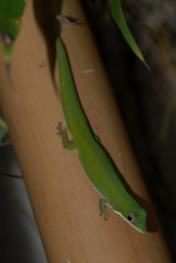Phelsuma vanheygeni
Description
A small, somewhat slender Phelsuma Gray 1825 with a total length of 75-80 mm (snout-vent length 31-35 mm), head, body and tail are rather flattened. In life, the dorsal coloration, including the head, neck, limbs and tail, is vivid green. Some small red dots irregularly positioned on the lower back and upper tail, usually slightly bigger red dots in males. The green dorsal coloration is bordered by a yellowish stripe, beginning at the rostral scale, over the supralabialia, under the ear opening, widening at the axilla, towards the groin. The ventral coloration is dirty white, the subcaudal scales have at the tips a brown to black pigmentation. Ventral and subcaudal scales are smooth (not keeled).
Distribution
Phelsuma vanheygeni is so far only known from the Ampasindava peninsula and from Djangoa. It is not unlikely that the species equally occurs in other parts of the Sambirano domain with similar habitats.
Terra Typica
Kongony, S 13° 39' 45.7", E 48°04'23.7", 50 m elevation, Ampasindava peninsula
Localities
Ambalihabe, Ambaliha, Bezavona, Djangoa, Kongony
Biotope
Phelsuma vanheygeni lives on medium sized bamboo (ø 5cm) in bamboo patches located; at the edge of the primary forest, within the forest and in secondary vegetation areas. Phelsuma vanheygeni shares its habitat with P. klemmeri, P. seippi, P. laticauda laticauda and P. grandis.
Biology
The eggs of P. vanheygeni are glued on the inside of bamboo. The young hatch within 25 days at a daytime temperature of about 27° C. The coloration of the juveniles is gold brown with 4 fine green to dark brown median stripes. The young are extremely small and measure about 25 mm. Regenerated skin of the adults is coloured gold brown like in the juvenile stage.

